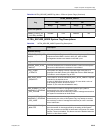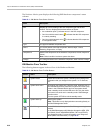
Polycom RealPresence Collaboration Server (RMX) 1500/2000/4000
23-2 Polycom, Inc.
The Hardware Monitor pane displays the following RMX hardware component’s status
columns:
HW Monitor Pane Tool bar
The following buttons appear in the tool bar of the Hardware Monitor:
Table 23-1 HW Monitor Pane Status Columns
Field Description
Slot Displays an icon according to the HW component type and the slot
number. The icon displays the hardware status as follows:
• An exclamation point (!) indicates errors in the HW component.
• Card icon with the reset button ( ) indicates that the HW component
is currently resetting.
• Card icon with diagnostic tools ( ) indicates that the HW component
is in diagnostic mode.
Type The type of hardware component card.
Status The current status of the HW component; Normal, Major, Critical,
Resetting, Diagnostics, or Empty.
Temperature Monitors the temperature of the hardware components; Normal, Major and
Critical.
Note: Critical condition invokes a system shut down.
Voltage The voltage threshold of the hardware component; either Normal or Major.
Table 23-2 HW Monitor Pane Tool Bar Buttons
Button Name Description
System Reset Resets and restarts the system. Resetting saves settings and
information that you changed in the system, i.e. IP Services,
etc...
System Shut Down Shuts down the system into a standby mode. When the user in
the RMX Manager/Client presses the System Shut Down (red)
button in the Hardware Monitor tool bar, the system should
enter a standby mode and the LED turns ON. Only the media
and control unit cards are in a standby mode. Shelf Manager
remains active.
Turn the system OFF/ON to exit the standby mode.
System Start Up Starts up the system.
Note: This button is only displayed when connecting directly to
the Shelf Management server.
Shelf Manager In the HW Monitor this opens the Shelf Management login
window.
In the Shelf Management HW Monitor this sets the MFA, CPU
and Switch (Cards: MPM/MPM+/MPMx, CNTL and RTM IP)
into diagnostic mode. For more information, see "Diagnostic
Mode (RMX 1500/2000/4000)” on page 23-21.


















